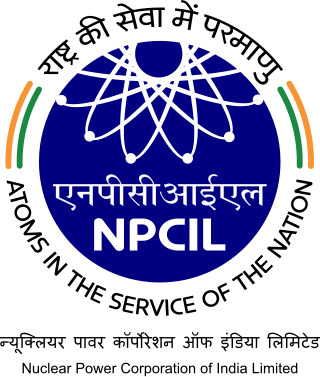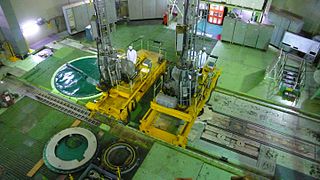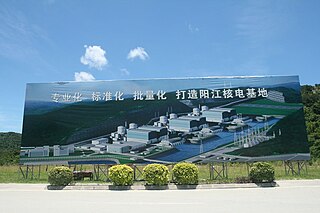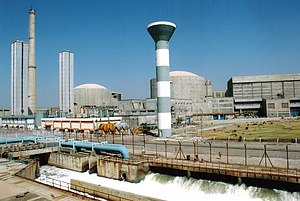
The Nuclear Power Corporation of India Limited (NPCIL) is an Indian public sector undertaking based in Mumbai, Maharashtra. It is wholly owned by the Government of India and is responsible for the generation of electricity from nuclear power. NPCIL is administered by the Department of Atomic Energy (DAE).

Kaiga Generating Station is a nuclear power generating station situated at Kaiga, near the river Kali, in Uttara Kannada district of Karnataka, India. The plant has been in operation since March 2000 and is operated by the Nuclear Power Corporation of India.

Generation III reactors, or Gen III reactors, are a class of nuclear reactors designed to succeed Generation II reactors, incorporating evolutionary improvements in design. These include improved fuel technology, higher thermal efficiency, significantly enhanced safety systems, and standardized designs intended to reduce maintenance and capital costs. They are promoted by the Generation IV International Forum (GIF).

Madras Atomic Power Station (MAPS) located at Kalpakkam about 80 kilometres (50 mi) south of Chennai, India, is a comprehensive nuclear power production, fuel reprocessing, and waste treatment facility that includes plutonium fuel fabrication for fast breeder reactors (FBRs). It is also India's first fully indigenously constructed nuclear power station, with two units each generating 220 MW of electricity. The first and second units of the station went critical in 1983 and 1985, respectively. The station has reactors housed in a reactor building with double shell containment improving protection also in the case of a loss-of-coolant accident. An Interim Storage Facility (ISF) is also located in Kalpakkam.
Tarapur is a census town in Palghar district in the Indian state of Maharashtra. It is an industrial town located some 45 km north of Virar, on the Western
The Chashma Nuclear Power Plant is a large commercial nuclear power plant located at Chashma in Mianwali, Punjab, Pakistan.

Rawatbhata is a city, Tehsil, Sub District and Nagar Palika in Chittorgarh District, Rajasthan, India. Rawatbhata is a Proposed District, It is 131 km from Chittorgarh city, 50 km from the nearest city, Kota. The city has eight nuclear power stations, a nuclear fuel complex and a heavy water plant. Rawatbhata also has the biggest dam of Rajasthan, Rana Pratap Sagar Dam, which is built on the Chambal River. The dam is equipped with a 172 MW hydroelectric power station.

Kudankulam Nuclear Power Plant is the largest nuclear power station in India, situated in Kudankulam in the Tirunelveli district of the southern Indian state of Tamil Nadu. Construction on the plant began on 31 March 2002, but faced several delays due to opposition from local fishermen. KKNPP is scheduled to have six VVER-1000 reactors built in collaboration with Atomstroyexport, the Russian state company and Nuclear Power Corporation of India Limited (NPCIL), with an installed capacity of 6,000 MW of electricity.

Kakrapar Atomic Power Station is a nuclear power station in India, which lies in the proximity of Mandvi, Surat and Tapi river in the state of Gujarat.
The Rajasthan Atomic Power Station is a nuclear power plant located at Rawatbhata in the state of Rajasthan, India.
Nuclear power is the fifth-largest source of electricity in India after coal, gas, hydroelectricity and wind power. As of November 2020, India has 23 nuclear reactors in operation in 8 nuclear power plants, with a total installed capacity of 7,380 MW. Nuclear power produced a total of 43 TWh in 2020–21, contributing 3.11% of total power generation in India. 10 more reactors are under construction with a combined generation capacity of 8,000 MW.

India's three-stage nuclear power programme was formulated by Homi Bhabha, the well-known physicist, in the 1950s to secure the country's long term energy independence, through the use of uranium and thorium reserves found in the monazite sands of coastal regions of South India. The ultimate focus of the programme is on enabling the thorium reserves of India to be utilised in meeting the country's energy requirements. Thorium is particularly attractive for India, as India has only around 1–2% of the global uranium reserves, but one of the largest shares of global thorium reserves at about 25% of the world's known thorium reserves. However, thorium is more difficult to use than uranium as a fuel because it requires breeding, and global uranium prices remain low enough that breeding is not cost effective.

Narora Atomic Power Station (NAPS) is a nuclear power plant located in Narora, Dibai Tehsil, Bulandshahar District in Uttar Pradesh, India.

The Yangjiang Nuclear Power Station is a nuclear power plant in Guangdong province, China. The site is Dongping Town, Yangjiang City in western Guangdong Province. The station has six 1,000 megawatt (MW) CPR-1000 pressurized water reactors (PWRs). The plant began commercial operation in March 2014, and as of 2019 is the largest nuclear power station in China.

The Hanbit Nuclear Power Plant is a large nuclear power station in the Jeollanam-do province of South Korea. The facility runs at an installed capacity of 5,875 MW. The power station is currently ranked as the fifth largest nuclear power station in the world. The plant's name was changed from Yeonggwang NPP to Hanbit in 2013 at the request of local fishermen.
The Darkhovin Nuclear Power Plant is a planned nuclear power plant located in Khuzestan province, Iran about 70 kilometers south of Ahvaz at the Karun river. Construction of one reactor has started. Some other projects on this site were cancelled. It's built by Masna.

The Gorakhpur Nuclear Power Plant or the Gorakhpur Haryana Anu Vidyut Pariyojana (GHAVP) is a proposed nuclear power plant to be built on a 560 hectares area west of Gorakhpur village of Fatehabad district of Haryana.

The IPHWR-700 is an Indian pressurized heavy-water reactor designed by the NPCIL. It is a Generation III reactor developed from earlier CANDU based 220 MW and 540 MW designs. It can generate 700 MW of electricity. Currently there is two unit operational, 6 units under construction and 8 more units planned, at a cost of ₹1.05 lakh crore (US$13 billion).














